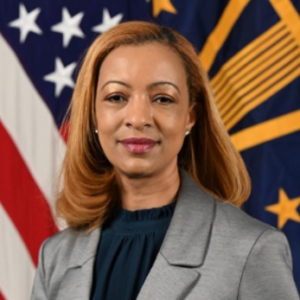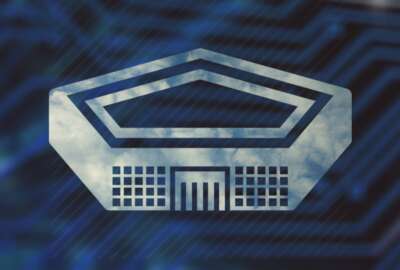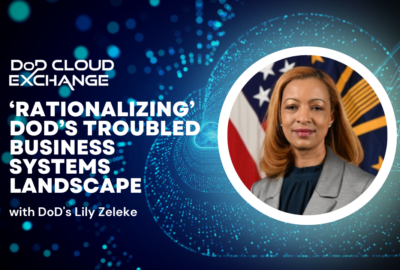DoD’s JWCC memo is a scene setter for the future of cloud
Lily Zeleke, the deputy chief information officer for the information enterprise at DoD, said the move to the Joint Warfighting Cloud Capability is as much about...
The Defense Department’s new memo detailing the next implementation steps for the Joint Warfighting Cloud Capability isn’t about mandates.
It’s more of a scene setter for where DoD’s chief information officer wants JWCC to take the military departments and defense services over the next decade.
Lily Zeleke, the deputy chief information officer for the information enterprise at DoD, said the Aug. 10 memo both helps to forecast and to broadcast the intention of the entire department about how to move current and future cloud capabilities to JWCC.

DoD awarded the JWCC contract, which could be worth $9 billion over 10 years, in December to Amazon Web Services, Google, Microsoft and Oracle.
“It basically tells the department that our intention is to maximize the use of JWCC, this enterprise cloud, multi-cloud capability to the maximum extent possible. In addition, it lays out that now that we have this multi-cloud capability for the enterprise, how do we look at what we have already in all the clouds, which have sprouted up for [real] needs, and help us rationalize?” Zeleke said in an exclusive interview with Federal News Network. “Ultimately, it also will hold every single one of us accountable that we’re going to do what we say, what’s in the memo and in the guidance and for the reasons that we put together this JWCC contract. We are going to establish good governance that’s going to help us walk that.”
John Sherman, the DoD CIO, set out several specific mandates in the guidance.
First, Fourth Estate agencies and the Office of the Secretary of Defense will move all current cloud capabilities to JWCC as their current contract period of performance expires. These organizations also will use JWCC for any new cloud requirements going forward.
Zeleke said the goal for Fourth Estate agencies is focused on two considerations. First is not to break any mission areas.
“Starting with the Fourth Estate for all in JWCC once contracts expire makes sense because we’re at an OSD level and they are providing enterprise capabilities for the most part, and there’s really no reason why the Fourth Estate and the OSD components should not hop on to JWCC. If there are reasons why not, then we’ll go through the evaluation process to determine what makes sense. We’re not going to do anything that doesn’t make sense,” she said on Ask the CIO. “But ultimately, we’ve gone through such great lengths to put together this incredible offering, and we want to make sure that we eat our own dog food if you will.”
All new cloud requirements to JWCC
Sherman strongly encourages the military services to use JWCC for unclassified needs, but there is no mandate to move current capabilities from Air Force’s Cloud One or the Army’s Enterprise Cloud Management Agency or any other vehicles at this time.
Sherman told the military services and combatant commands to use JWCC for all new cloud requirements at the unclassified and top secret levels, including for those needs at the tactical edge and outside the continental U.S.
Additionally, Sherman told their entire DoD to use JWCC for secret, or Impact Level 6, and top secret cloud needs.
“For the military departments, they have made a lot of investments in establishing, especially on the unclassified side, quite a bit of their cloud activities that are really driving a lot of the warfighting missions. We really don’t want to break their mission, so we are lenient on the unclassified piece, but we strongly encourage, if it is possible for them to use JWCC, for the unclassified piece,” Zeleke said. “For the secret and top secret piece, especially the top secret piece, there was an incredible gap that we had in DoD. We really want JWCC to be used to the maximum extent possible. It really makes sense from just overall mission perspective that we really need to be in a joint manner, and that we need to be interoperable and consistent across the board. That was the idea behind it, to really walk this wisely.”
She added JWCC has to be an enabler to the mission and if the military services, combatant commands and defense agencies don’t understand that, then JWCC will not be successful.
The second goal is to stop or limit the siloed, or one off, cloud contracts DoD has been adopting over the past decade and take advantage of the enterprise-wide benefits of JWCC ranging from price to security to innovation.
Zeleke said DoD has piecemealed a lot of the top secret and secret cloud capabilities up to this point.
“The requirements are now expanding, especially on the digital battlefield, where that’s really where most of pacing threat, and cybersecurity as the fight really evolves and the mission needs evolve, we’re seeing more and more that piece of the fabric is becoming even more critical,” she said. “Our joint-ness is becoming more critical. I’m sure you’ve heard of JADC2, the Joint All Domain Command and Control, initiative, it’s not that we didn’t do it before, but now it’s an even more imperative to keep pace with the pacing challenge and threat. JWCC is at the heart of how we really are enabled to use advanced capabilities and cybersecurity that we need to continue and evolve our mission.”
DoD’s new governance council
Underpinning all of these consolidation and rationalization efforts is a new governance body, the DoD Enterprise Information Portfolio Management, Modernization and Capabilities Council (DoD-IE-PM2C).
Zeleke said the new oversight body moves DoD away from the old net-centric governance approach and toward a data-centric approach.
“Our cloud initiatives and activities are now going to be going through this process, but also if you look at software category management, which is really ultimately, directly tied to why do we move to the cloud, it is really about evolving our software portfolio,” she said. “We’re going to do all of these things in a more current, streamlined and collaborative way. That’s the other piece, this is not a DoD CIO only walk or a DISA only walk, this requires incredible collaboration across the department and we’re taking all of that into account. We just needed to evolve our governance, and really say that we are going to take this cloud piece, as well as the guidance that we put out, and we’re going to implement in a real way and really remove barriers and ceremonial things to do some serious work in this governance.”
The governance council will start by asking the military services and defense agencies to data to begin the rationalization process. Zeleke said to take advantage of the buying power of the department, particularly through JWCC, they first have to understand what is being bought and by whom.
“The shift we’re making with this governance is that this is a hole of DoD governance that we’re going to try to make sure that it remains accountable. We track what we need to do and do what we say. I think it was an imperative that we evolve the governance process,” she said. “One of the things that we’re driving as a priority is enabling tactical edge, global compute fabric. That doesn’t happen just on its own. It’s going to require us to have that connectivity, interoperability, the ability to work together as an entire department, and really across the federal entities as well as our coalition partners. As you see all those things materialize, that’s the kind of thing that we’re beginning to enable. It’s laid out in our software modernization implementation plan as we’re not moving to cloud just to move to cloud. We’re really enabling some serious critical capabilities that we’ve laid out.”
Copyright © 2025 Federal News Network. All rights reserved. This website is not intended for users located within the European Economic Area.
Jason Miller is executive editor of Federal News Network and directs news coverage on the people, policy and programs of the federal government.
Follow @jmillerWFED









